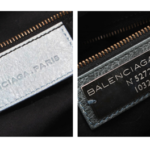How to Authenticate Balenciaga Handbags
The brand Balenciaga is the namesake fashion house of Spanish designer Cristobal Balenciaga, and was founded in 1919. The label reached peak renown in the post-war era, alongside contemporaries like Christian Dior and Hubert de Givenchy. It exists today as a ready-to-wear label and is owned by the French fashion conglomerate Kering.
French designer Nicolas Ghesquiere brought his talents to the house in 1997, and established some of the iconic leather goods that consumers associate with Balenciaga today. These include the motorcycle-inspired handbags, which were first produced in 2001, and have been ubiquitous among celebrities and fashion editors ever since.
Before you make the investment, make sure you’re getting the real thing. Authentic Balenciaga motorcycle bags will retain value over the years, and they can be identified using the following key indicators.
1. Interior Labels
The interior label will be printed on a metal name plate or a leather tab. From 2001-2004, the label read Balenciaga_Paris, but in 2005 the underscore between Balenciaga and Paris was replaced with a period. In 2012 with the introduction of creative director Alexander Wang, the word Paris was placed underneath the word Balenciaga.
From 2001-2008, labels made of metal were sterling silver, although today they are made of nickel. The handbag’s style number will be listed on the front or the back of the tab; sometimes it will be on both sides. Make sure the serial number on the front of the label (if there is one) matches the serial number on the back. The two rows of numbers on the back of the tab correspond to the leather batch number and the style number, respectively.
2. Hardware
Balenciaga motorcycle bags are known for their edgy stud hardware, which come in 3 styles – classic, giant, or covered. The back of the recent handbag’s handles should have notched rivets. Zippers should be marked Lampo, and the bales which attach the handle to the O-rings on the side of the bag should be rounded, crimped and form a double layer. As of Spring 2012, the Giant Silver and Rose Gold hardware has been discontinued, and replaced with the new Giant 12 hardware.
3. Materials
Originally, Motorcycle bags were made of goatskin leather, but production has switched to lambskin leather since Fall 2007. These two leathers are characteristically thin, soft and lightweight, and distress with age. This crinkling, aged look should be no cause for alarm, as Motorcycle bags are also traditionally very durable. The difference between goat and lambskin is very slight; many do not discern a significant difference between the feel and appearance of the two. Oftentimes, a counterfeit handbag will use a shiny or stiff leather that does not wear in the same way as an authentic bag – there is no softening, or matte quality to the textile.
3. Materials
Originally, Motorcycle bags were made of goatskin leather, but production has switched to lambskin leather since Fall 2007. These two leathers are characteristically thin, soft and lightweight, and distress with age. This crinkling, aged look should be no cause for alarm, as Motorcycle bags are also traditionally very durable. The difference between goat and lambskin is very slight; many do not discern a significant difference between the feel and appearance of the two. Oftentimes, a counterfeit handbag will use a shiny or stiff leather that does not wear in the same way as an authentic bag – there is no softening, or matte quality to the textile.


